
The book of hours is a Christian devotional book popular in the Middle Ages. It is the most common type of surviving medieval illuminated manuscript. Like every manuscript, each manuscript book of hours is unique in one way or another, but most contain a similar collection of texts, prayers and psalms, often with appropriate decorations, for Christian devotion. Illumination or decoration is minimal in many examples, often restricted to decorated capital letters at the start of psalms and other prayers, but books made for wealthy patrons may be extremely lavish, with full-page miniatures. These illustrations would combine picturesque scenes of country life with sacred images. Books of hours were usually written in Latin, although there are many entirely or partially written in vernacular European languages, especially Dutch. The English term primer is usually now reserved for those books written in English. Tens of thousands of books of hours have survived to the present day, in libraries and private collections throughout the world.

The Froissart of Louis of Gruuthuse is a heavily illustrated deluxe illuminated manuscript in four volumes, containing a French text of Froissart's Chronicles, written and illuminated in the first half of the 1470s in Bruges, Flanders, in modern Belgium. The text of Froissart's Chronicles is preserved in more than 150 manuscript copies. This is one of the most lavishly illuminated examples, commissioned by Louis of Gruuthuse, a Flemish nobleman and bibliophile. Several leading Flemish illuminators worked on the miniatures.

Simon Bening was a Flemish miniaturist, generally regarded as the last major artist of the Netherlandish tradition.
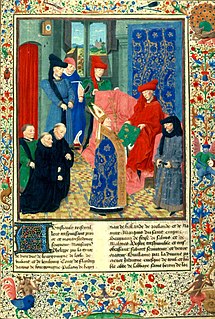
Simon Marmion was a French and Burgundian Early Netherlandish painter of panels and illuminated manuscripts. Marmion lived and worked in what is now France but for most of his lifetime was part of the Duchy of Burgundy in the Southern Netherlands.

The Getty Tondal, also known as Les visions du chevalier Tondal is an illuminated manuscript from 1475, now in the Getty Museum. It is a French version and is the only surviving fully illuminated manuscript of the Visio Tnugdali. It has 20 miniatures by Simon Marmion and elaborate borders with "CM" for the initials of Margaret of York, Duchess of Burgundy and her husband Charles the Bold. The text was scribed by David Aubert in Ghent, while the miniatures were done in Valenciennes, where Marmion was based. Only the fifteen pages with two-column miniatures and five pages with single column miniatures have borders. There are only 45 folios, meaning that most have miniatures. The manuscript is fully available online.
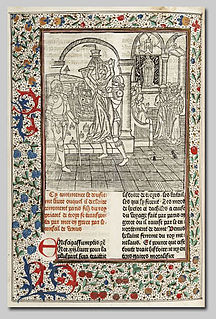
Colard Mansion was a 15th-century Flemish scribe and printer who worked together with William Caxton. He is known as the first printer of a book with copper engravings, and as the printer of the first books in English and French.

The Master of Anthony of Burgundy was a Flemish miniature painter active in Bruges between about 1460 and 1490, apparently running a large workshop, and producing some of the most sophisticated work of the final flowering of Flemish illumination. He was first identified by Winkler in 1921; his name is derived from one of his most elevated patrons, Anthony of Burgundy, Philip the Good's illegitimate son, though he also worked for the Dukes and other bibliophiles in Burgundian court circles, who had already been allocated "Masters" by art historians. His contributions to the heavily illustrated Froissart of Louis of Gruuthuse from the early 1470s, on which several of the leading illuminators of the day worked, show him excelling some more famous names, like Loiset Lyédet. The young Master of the Dresden Prayer Book worked as his assistant on this book, suggesting he was an apprentice; a number of other anonymous masters have been postulated as his pupils. Other works are in the libraries of Paris, Wrocław, Philadelphia, Munich, Cambridge University Library and elsewhere.
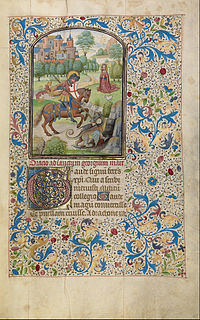
Willem Vrelant was a Dutch book illuminator.

The Hours of Mary of Burgundy is a book of hours, a form of devotional book for lay-people, completed in Flanders around 1477. It was probably commissioned for Mary, the ruler of the Burgundian Netherlands and then the wealthiest woman in Europe. No records survive as to its commission. The book contains 187 folios, each measuring 22.5 by 15 centimetres. It consists of the Roman Liturgy of the Hours, 24 calendar roundels, 20 full-page miniatures and 16 quarter-page format illustrations. Its production began c. 1470, and includes miniatures by several artists, of which the foremost was the unidentified but influential illuminator known as the Master of Mary of Burgundy, who provides the book with its most meticulously detailed illustrations and borders. Other miniatures, considered of an older tradition, were contributed by Simon Marmion, Willem Vrelant and Lieven van Lathem. The majority of the calligraphy is attributed to Nicolas Spierinc, with whom the Master collaborated on other works and who may also have provided a number of illustrations.

The Hours of Joanna I of Castile is a sixteenth-century illuminated codex housed in the British Library, London, under call number Add MS 35313.

Lieven van Lathem (1430–1493), was an Early Netherlandish painter and manuscript illuminator.
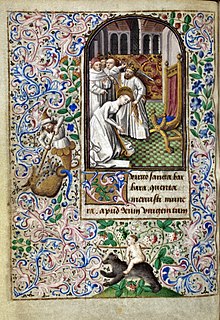
The Book of Hours of Simon de Varie is a French illuminated manuscript book of hours commissioned by the court official Simon de Varie, with miniatures attributed to at least four artists; hand A who may have been a workshop member of the Bedford Master, the anonymous illustrators known as the Master of Jean Rolin II, the Dunois Master and the French miniaturist Jean Fouquet. It was completed in 1455 and consists of 49 large miniatures and dozens of decorative vignettes and painted initials, which total over 80 decorations. Fouquet is known to have contributed six full leaf illuminations, including a masterwork Donor and Virgin diptych. A number of saints appear - Saint Simon is placed as usual alongside Saint Jude ; other pages feature saints Bernard of Menthon, James the Greater and Guillaume de Bourges.
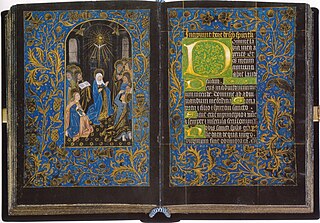
Black books of hours are a type of luxury Flemish illuminated manuscript books of hours using pages of vellum that were soaked with black dye or ink before they were lettered or illustrated, for an unusual and dramatic effect. The text is usually written with gold or silver ink. There are seven surviving examples, all dating from about 1455–1480.

A presentation miniature or dedication miniature is a miniature painting often found in illuminated manuscripts, in which the patron or donor is presented with a book, normally to be interpreted as the book containing the miniature itself. The miniature is thus symbolic, and presumably represents an event in the future. Usually it is found at the start of the volume, as a frontispiece before the main text, but may also be placed at the end, as in the Vivian Bible, or at the start of a particular text in a collection.

The Master of Mary of Burgundy was a Flemish illuminator, painter and draughtsman active between 1469-1483 in Flanders, probably in Ghent. His notname is derived from two books of hours attributed to him, the Vienna Hours of Mary of Burgundy and another books of hours, now in Berlin, also for Mary of Burgundy.

The Chronicles of Hainaut is an illuminated manuscript in three volumes, tracing the history of the county of Hainaut up to the end of the 14th century. Its text was produced around 1446-1450 by Jean Wauquelin as a French translation of Annales historiae illustrium principum Hannoniæ, a three-volume Latin work produced by Jacques de Guise around 1390-1396. It was made for Philip the Good of Burgundy and is now in the Bibliothèque royale de Belgique in Brussels.
Antoine Philippe De Schryver (1924–2005) was a Belgian art historian and professor at the University of Ghent, where he lectured on History of Book Illumination. He was specialized in the field of illuminated manuscripts in the Southern Netherlands, 15th century painting, and artists at the Burgundian Court.
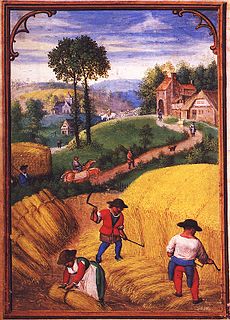
The Munich-Montserrat Book of Hours is a 1535 illuminated manuscript book of hours. It measured 10 by 14 cm in its original form. It was produced by Simon Bening and his workshop, possibly for Alonso de Idiaquez, royal secretary to Charles V, Holy Roman Emperor. Its miniatures are stylistically similar to other books of hours by Bening and his workshop such as the Da Costa Book of Hours, the Hennessy Book of Hours and the Hours of Isabella of Portugal, all produced for Spanish nobles.
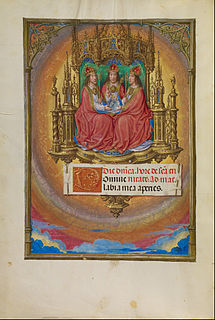
The Spinola Book of Hours is a sixteenth-century illuminated manuscript, consisting of 310 folios with 84 fully illustrated miniature paintings. This medieval manuscript was produced in the region between Bruges and Ghent in Flanders around 1510-1520. According to Thomas Kren, a former curator of the J. Paul Getty Museum, the artwork within the Spinola Hours can be attributed to five distinct artists. Forty-seven of these illuminated pages can be accredited to the 'Master of James IV'. The Spinola Hours bears a central coat-of-arms on the cover indicating it belonged to the Spinola family of Genoa. Today it is located at the J. Paul Getty Museum in Los Angeles.
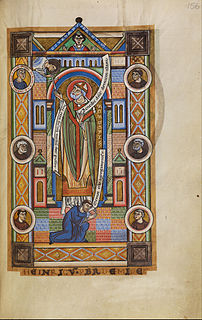
The Stammheim Missal is an illuminated manuscript Roman missal now in the J. Paul Getty Museum, which bought it from the barons of Fürstenberg's private collection; they sold it to raise funds to repair Schloss Körtlinghausen. A Carolingian ivory diptych had been used on or for its binding, but was taken off in 1904 and was in the State Museums of Berlin, where it disappeared during the museum's bombing in 1945.

















